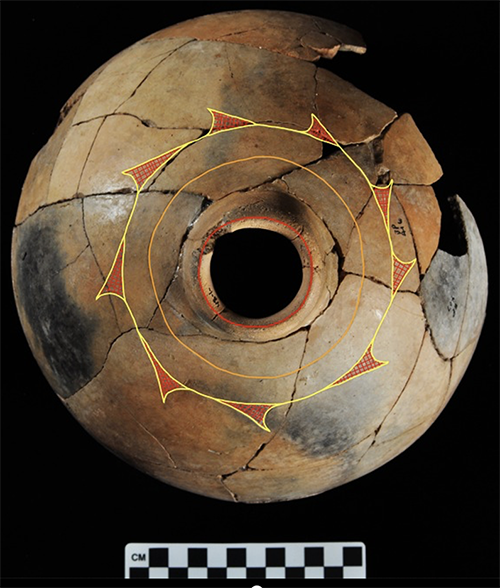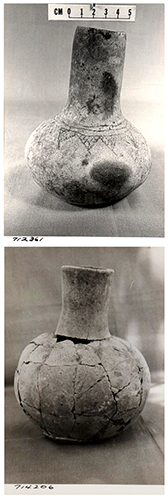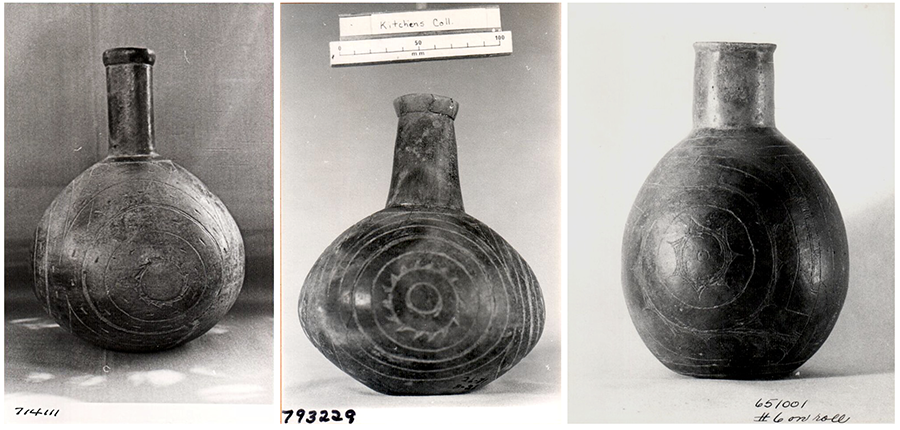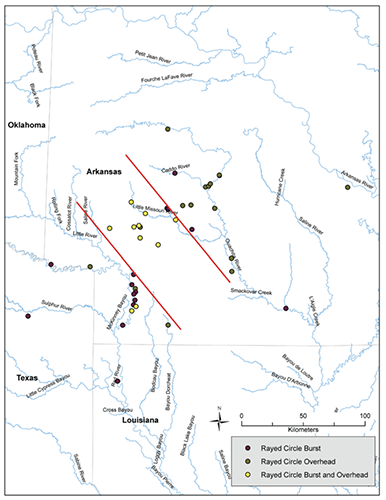The following is an excerpt from: (2016) Distribution of Design: The Rayed Circle. Caddo Archeology Journal 26:29-42.

The importance of the use of a Geographic Information System, or GIS, in archaeological analyses should be familiar to most anthropologists today. The value that a GIS gives an anthropological archaeologist is an ability to conduct multivariate spatial analyses in order to examine complex social relationships, interactions, and distributions across a broad cultural landscape. Herein, I present initial findings using this GIS distributional approach related to an on-going project to explore the iconographic distribution of the visual imagery depicted on ceramic vessels. In addition, this initial analysis provides a database framework containing attributes from over 4,000 Caddo ceramic vessels that can be further applied and compared to a variety of cultural metadata as part of a larger ceramic distribution project.
In short, I thought it worthwhile to explore the feasibility of using a motif based distribution analysis rather than a type-variety based examination with a simple goal: Is an iconographic approach viable given the general nature of Caddo ceramics as mostly abstract in design containing largely geometric rather than the more figural motifs that are prevalent east of the Mississippi River?
At this point in the project, the GIS database contains 4199 vessels. The total number of ceramic vessels containing site coordinates is 3399 collected over the years by looters, avocationalists, and archaeologists from 187 archaeological sites in 36 counties and 5 parishes, primarily within the state of Arkansas. Sites containing the most ceramics include some recognizable locales, including Battle Mound, Mineral Springs, Washington, Flowers, Bowman, East, Hays, and Haley.
Each of these vessels are those that were originally recorded on numerous orange index of cards – what has been referred to as the “analog database” – and contain vessel images along with site information, collector information, repository, and intrasite provenience information where noted. The images of the vessels were photographed mostly from private collections in the 1960s, 70s and 80s by several Arkansas Archeological Survey station archaeologists, station assistants, and students.

THE RAYED CIRCLE
As one of the more easily identifiable motifs on Caddo ceramics, I decided to begin exploring an iconographic distribution using a rayed circle motif. The choice of using the rayed circle as a case study was influenced by a single Hempstead Engraved bottle, excavated in 1948 from a structure floor on the large mound at the Battle site. When viewed in profile, it, and many other Hempstead Engraved bottles contain a design motif composed of a series of triangles filled with engraved cross-hatching and located at the base of the neck. The triangles are pointed downward in a fairly symmetrical organization and connected, if you will, at the base of the triangles by a single circular engraving often with an accompanying set of nested concentric circles.
I pondered what the Hempstead Engraved bottle design might look like from above, that is the visual perspective of the bottle being used rather than being on display. Since the bottle vessel form was likely used for storing and pouring liquids into other vessels, such as bowls, or drinking from it directly, it is suggested that the motif was designed from an overhead perspective with the bottle opening an important central element – a possible symbolic portal from whence the liquid in the bottle passes through. As such, when viewed from overhead, the downward triangle motif resembles what I call a Rayed-Circle Overhead motif in keeping with the use of the term “rayed circle” in iconographic literature, most notably by Phillips in Brown in their Spiro Shell Engraved volume and the accompanying Glossary of Motifs. So it was with this Hempstead bottle that I began building a corpus of rayed circle motifs.
THE RAYED CIRCLE MOTIF – BURST
A total of 85 vessels have been identified that contain the rayed circle burst motif. Design elements are located on the body of the vessel, most of them on bottles. The central element, or burst, is a circle containing a series of small triangles or rays emanating outward from the center. A least one burst defines the motif, although in most cases they are seemingly multiple bursts organized symmetrically with two or four on opposing sides. However, this is not explicit given that I’m only looking at the ceramics in the photographs from one side. While the rayed circle burst defines the corpus, there are variations to the overall theme.

The 85 rayed circle burst vessels are all from sites containing Middle and Late Caddo components, circa A.D. 1200 to about A.D. 1600 depending on the specific locale, although many of the sites have not been studied fully to more distinctly understand their temporal components. When examined across the Caddo landscape, some preliminary spatial patterns can be identified.
First, vessels with the rayed circle burst motif have been found at sites located along major rivers and tributaries, including Red River, Caddo River, Little Missouri River and tributaries, Antoine River, Mine Creek as a tributary to the Little River, Ozan Creek drainage in Hempstead County, a single vessel along the Lower Ouachita in Union County, and a single vessel along the Sulphur River in Texas.
Second, vessels are clustered primarily in two areas, along the Great Bend of the Red River and northeast of the Red River along the Caddo, Little Missouri, Saline tributary, and Ozan Creek drainage. Forty-one or 48 percent of vessels are located within the Great Bend area and 32 or 38 percent are located in the second cluster to the northeast. In terms of the number of sites represented, eight sites in the Great Bend contain rayed circle burst vessels whereas thirteen sites in the northeast cluster are represented. In other words, the Great Bend area contains a larger number of rayed circle burst vessels yet they are in more concentrated occurrences at less sites. For example, the total vessels found at Battle Mound and Haley Place constitutes 49 percent of the Great Bend vessels and 25 percent of the entire rayed circle burst corpus.
RAYED CIRCLE MOTIF – OVERHEAD
A second rayed circle motif is what I refer to as the rayed circle overhead motif. There are 65 representations of the overhead motif in the corpus. As with the rayed circle burst motif, all come from what are likely Middle and Late Caddo period sites. The primary motif is composed of a series of triangles filled with engraved cross-hatching and located at the base of the neck. The triangles are pointed downward from a circular engraving often with an accompanying set of nested concentric circles. As stated previously, I’m proposing that the design organization is best viewed from overhead during use, rather than in profile.

About half of vessel forms containing the rayed circle overhead motif are bottles and the remaining are bowls. The motif on bowls is almost identical to those on the bottles. The bowls all contain a series of triangles filled with engraved cross-hatching and are pointed downward from a circular engraving often with an accompanying set of nested concentric circles. However, as a result of the bowl form, the overhead motif is not fully visible from overhead. I offer the following suppositional suggestion: the identification of a second vessel form containing interchangeable design elements suggests a functional, perhaps symbolic relationship or even a common identifier between the bottles and bowls. In other words, might the bowls represent the container in which the liquid from the bottles was poured into? Of course this is purely an observation and would require empirical testing of trace elements. Nonetheless, it is a consideration for the similarity in design across vessel form and a hypothesis to test.
The distribution of the rayed circle overhead motif is much more dispersed than the more concentrated rayed circle burst motif occurrences. There are no visible clusters and the motif is well represented throughout the major rivers and associated tributaries, although there are minor concentrations along the Ouachita and Ozan drainage area.

COMBINATION DISTRIBUTION
When the two motifs are examined in together, an interesting spatial patterning is observable. The combination of motifs reveals a possible corridor of sites in the proximity of Little Missouri, Ozan Drainage, and Caruse Creek. Initial observations suggest the possibility of diffusion of the overhead motif from the northeast and the burst motif from the southwest, with an overlapping combination of both representations situated between.
This case study offers some points to explore with regard to spatial relationships and cultural interactions. However, temporal information is only understood at a broad resolution with many sites lacking the much needed absolute dating to firmly organize their occupational history into a cultural landscape chronology. In order to examine directions of design and possible associated ideological influence, a more specific chronology needs to be developed. This will be challenging since many of these vessels do not contain intrasite provenience and thus at present are restricted to relative dating techniques.
A second concern is the somewhat subjective and biased nature of the corpus. This is most evident in the two-dimensional visibility of the vessels. These are photographs and I am only looking at one side of each vessel. Additionally, the corpus is developed from incomplete or selective data gathered by collectors, hence the need to broaden the database to include vessels in publications as well as adjoining states.
Future directions include perusing the literature for additional vessels not only within Arkansas but also outside of the state to include those in Louisiana, Texas, and Oklahoma. Additionally, I hope to broaden the database to include vessels outside of the Caddo area, beginning first with those in Arkansas counties along the Mississippi River followed by a broader scale to include sites throughout the Mississippi delta and beyond.
For more information:
| Girard, Jeffrey S., Timothy K. Perttula, and Mary Beth Trubitt 2014 Caddo Connections: Cultural Interactions within and Beyond the Caddo World. Rowman & Littlefield Publishers. Hodder, Ian and Clive Orton 1979 Spatial Analysis in Archaeology. Cambridge University Press. McKinnon, Duncan P. 2011 Foster Trailed-Incised: A GIS-Based Analysis of Caddo Ceramic Distribution. Caddo Archeology Journal 21:71-88. Phillips, Philip and James A. Brown 1978 Pre-Columbian Shell Engravings from the Craig Mound at Spiro, Oklahoma. Volume 1, Cambridge, Peabody Museum Press. Wheatley, David, and Gillings, Mark 2002 Spatial Technology and Archaeology: The Archaeological Applications of GIS. Taylor and Frances, London. |